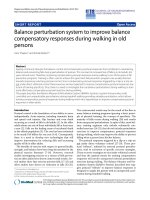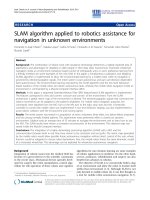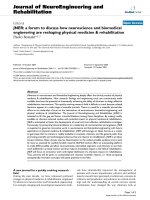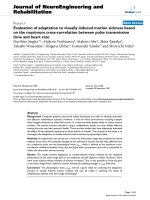Báo cáo hóa học: " Infinitely many solutions to superlinear second order m-point boundary value problems" potx
Bạn đang xem bản rút gọn của tài liệu. Xem và tải ngay bản đầy đủ của tài liệu tại đây (311.07 KB, 11 trang )
Ma et al. Boundary Value Problems 2011, 2011:14
/>
RESEARCH
Open Access
Infinitely many solutions to superlinear second
order m-point boundary value problems
Ruyun Ma1*, Chenghua Gao1 and Xiaoqiang Chen2
* Correspondence: mary@nwnu.
edu.cn
1
Department of Mathematics,
Northwest Normal University,
Lanzhou, 730070, PR China
Full list of author information is
available at the end of the article
Abstract
We consider the boundary value problem
u (x) + g(u(x)) + p(x, u(x), u (x)) = 0,
x ∈ (0, 1),
m−2
u(0) = 0,
αi u(ηi ),
u(1) =
i=1
where:
(1) m ≥ 3, hi Ỵ (0, 1) and ai >0 with A :=
(2) g : ℝ ® ℝ is continuous and satisfies
g(s)s > 0, s = 0,
m−2
i=1
αi < 1;
and
lim
s→∞
g(s)
= ∞;
s
(3) p : [0, 1] ì 2 đ is continuous and satisfies
|p(x, u, v)| ≤ C + β|u|,
x ∈ [0, 1](u, v) ∈ R2
for some C >0 and b Ỵ (0, 1/2).
We obtain infinitely many solutions having specified nodal properties by the
bifurcation techniques.
MSC(2000). 34B15, 58E05, 47J10
Keywords: Nodal solutions, Second order equations, Multi-point boundary value problems, Bifurcation
1 Introduction
We consider the nonlinear boundary value problem
u (x) + g(u(x)) + p(x, u(x), u (x)) = 0,
x ∈ (0, 1),
(1:1)
m−2
u(0) = 0,
αi u(ηi ),
u(1) =
(1:2)
i=1
where
© 2011 Ma et al; licensee Springer. This is an Open Access article distributed under the terms of the Creative Commons Attribution
License ( which permits unrestricted use, distribution, and reproduction in any medium,
provided the original work is properly cited.
Ma et al. Boundary Value Problems 2011, 2011:14
/>
Page 2 of 11
(H1) m ≥ 3, hi Ỵ (0, 1) and ai >0 with
m−2
αi < 1;
A :=
i=1
(H2) g : ℝ ® ℝ is continuous and satisfies
g(s)s > 0,
s = 0,
(1:3)
and
lim
s→∞
g(s)
= ∞;
s
(1:4)
(H3) p : [0, 1] ì 2 đ is continuous and satisfies
|p(x, u, v)| ≤ C + β|u|,
x ∈ [0, 1], (u, v) ∈ R2
(1:5)
for some C >0 and b Ỵ (0, 1/2).
In order to state our results, we first recall some standard notations to describe the
nodal properties of solutions. For any integer, n ≥ 0, Cn[0, 1] will denote the usual
Banach space of n-times continuously differentiable functions on [0, 1], with the usual
sup-type norm, denoted by || · ||n. Let X := {u Ỵ C2[0, 1]: u satisfies (1.2)}, Y := C0[0,
1], with the norms | · |2 and | · |0, respectively. Let
E := {u ∈ C1 [0, 1] : u satisfies (1.2)},
with the norms | · |E.
We define a linear operator L : X ® Y by
Lu := −u ,
u ∈ X.
(1:6)
In addition, for any continuous function g : đ and any u ẻ Y, let g(u) Ỵ Y
denote the function g(u(x)), x Ỵ [0, 1].
Next, we state some notations to describe the nodal properties of solutions of (1.1),
see [1] for the details. For any C1 function u, if u(x0) = 0, then x0 is a simple zero of u,
if u’(x 0 ) ≠ 0. Now, for any integer k ≥ 1 and any ν Ỵ {+, -}, we define sets
Sν ,
k
ν
k
⊂ C2 [0, 1] consisting of the set of functions u Ỵ C2[0, 1] satisfying the following
conditions:
Sν
k
(i) u(0) = 0, νu’(0) >0; (ii) u has only simple zeros in [0, 1] and has exactly k - 1 zeros
in (0, 1).
ν
k
(i) u(0) = 0, νu’(0) >0; (ii) u’ has only simple zeros in (0, 1) and has exactly k such
zeros; (iii) u has a zero strictly between each two consecutive zeros of u’.
ν
ν
Remark 1.1 If we add the restriction u’ (1) ≠ 0 on the functions in k then k
ν
ν
ν
becomes the set Tk , which used in [1]. The reason we use k rather than Tk is that the
Equation (1.1) is not autonomous anymore.
In [1, Remarks 2.1 and 2.2], Rynne pointed out that
Ma et al. Boundary Value Problems 2011, 2011:14
/>
Page 3 of 11
ν
a. If u ∈ Tk , then u has exactly one zero between each two consecutive zeros of u’,
and all zeros of u are simple. Thus, u has at least k - 1 zeros in (0, 1), and at most k
zeros in (0, 1];
ν
b. The sets Tk are open in X and disjoint;
ν
c. When considering the multi-point boundary condition (1.2), the sets Tk are in fact
ν
more appropriate than the sets Sk.
The main result of this paper is the following
Theorem 1.1 Let (H1)-(H3) hold. Then there exists an integer k0 ≥ 1 such that for
all integers k ≥ k0 and each ν Ỵ {+, -} the problem (1.1), (1.2) has at least one solution
ν
uν ∈ k .
k
Superlinear problems with classical boundary value conditions have been considered
in many papers, particularly in the second and fourth order cases, with either periodic
or separated boundary conditions, see for example [2-11] and the references therein.
Specifically, the second order periodic problem is considered in [2,3], while [4-7] consider problems with separated boundary conditions, and results similar to Theorem 1.1
were obtained in each of these papers. The fourth order periodic problem is considered in [8-10]. Rynne [11] and De Coster [12] consider some general higher order problems with separated boundary conditions also.
Calvert and Gupta [13] studied the superlinear three-point boundary value problem
u (x) + g(u(x)) + p(x, u(x), u (x)) = 0,
u(0) = 0,
x ∈ (0, 1),
(1:7)
u(1) = βu(η),
(1:8)
(which is a nonlocal boundary value problem), under the assumptions:
(A0) b Ỵ (0, 1) ∪ (1, ∞);
(A1) g : ℝ ® ℝ is continuous and satisfies g(s)s >0, s ≠ 0,
lim
|s|
g(s)
is
s
increasing and
g(s)
= ;
s
(A2) p : [0, 1] ì 2 đ ℝ is a function satisfying the Carathéodory conditions and
satisfies
|p(x, u, v)| ≤ M1 (t, max(|u|, |v|)),
x ∈ [0, 1], (u, v) ∈ R2 ,
where M1 : [0, 1] × [0, ∞) ® [0, ∞) satisfies the condition: for each s Î [0, ∞), M1(·,
s) is integrable on [0, 1] and for each t Ỵ [0, 1], M1(t, ·) is increasing on [0, ∞) with
s−1
1
0
M1 (t, s)ds → 0 as s ® ∞.
Calvert and Gupta used Leray-Schauder degree and some ideas from Henrard [14]
and Cappieto et al. [5] to prove the existence of infinity many solutions for (1.7), (1.8).
Their results extend the main results in [14].
It is the purpose of this paper to use the global bifurcation theorem, see [15] and [1],
to obtain infinity many nodal solutions to m-point boundary value problems (1.1), (1.2)
under the assumptions (H1)-(H3). Obviously, our conditions (H2) and (H3) are much
weaker than the corresponding restrictions imposed in [13]. Our paper uses some of
ideas of Rynne [10], which deals with fourth order two-point boundary value problems.
By the way, the proof [10, Lemma 2.8] contains a small error (since ||u″|0 ≥ ζ4(0) ⇏ |u
″|0 ≥ ζ4(R) there). So, we introduce a new function c (see (3.7)) with
Ma et al. Boundary Value Problems 2011, 2011:14
/>
Page 4 of 11
χ (0) ≥ ζ2 (R)
which are required in applying Lemma 3.4.
2 Eigenvalues of the linear problem
First, we state some preliminary results related to the linear eigenvalue problem
Lu = λu,
u ∈ X.
(2:1)
Denote the spectrum of L by s(L). The following spectrum results on (2.1) were
established by Rynne [1], which extend the main result of Ma and O’Regan [16].
Lemma 2.1. [1, Theorem 3.1] The spectrum s(L) consists of a strictly increasing
sequence of eigenvalues l k >0, k = 1, 2, ..., with corresponding eigenfunctions
1/2
φk (x) = sin(λk x). In addition,
(i) limk®∞ lk = ∞;
ν
(ii) φ ∈ Tk , for each k ≥ 1, and j1 is strictly positive on (0, 1).
Lemma 2.2 [1, Theorem 3.8] For each k ≥ 1, the algebraic multiplicity of the characteristic value lk of L-1 : Y ® Y is equal to 1.
3 Proof of the main results
For any u Ỵ X, we define e(u)(·): [0, 1] ® ℝ by
x ∈ [0, 1].
e(u)(x) = p(x, u(x), u (x)),
It follows from (1.5) that
|e(u)(x)| ≤ C + β|u(x)|,
x ∈ [0, 1].
(3:1)
For any s Ỵ ℝ, let
s
g(τ )dτ ≥ 0,
G(s) =
0
and for any s ≥ 0, let
γ (s) = max{|g(r)| : |r| ≤ s},
(s) = max{G(r) : |r| ≤ s}.
We now consider the boundary value problem
u + λu + α(g(u) + e(u)) = 0,
u ∈ X,
(3:2)
where a Ỵ [0, 1] is an arbitrary fixed number and l Ỵ ℝ. In the following lemma (l,
u) ẻ ì X will be an arbitrary solution of (3.2).
By (H2), we can choose b1 ≥ 1 such that
|s| ≥ b1 ⇒ |g(s)| ≥ C + β|s|.
(3:3)
By (1.2), we have the following
Lemma 3.1. Let (H1) hold and let u Ỵ X. Then
|u|0 ≤ |u |0 ≤ |u |0 .
(3:4)
Ma et al. Boundary Value Problems 2011, 2011:14
/>
Page 5 of 11
Lemma 3.2. Let u be a solution of (3.2). Then for any x0, x1 Ỵ [0, 1],
u (x1 )2 + λu(x1 )2 + 2αG(u(x1 )) = u (x0 )2 + λu(x0 )2 + 2αG(u(x0 ))
x1
−2α
e(u)(s)u (s)ds.
x0
Proof. Multiply (3.2) by u’ and integrate from x0 to x1, then we get the desired result.
■
In the following, let us fix R Ỵ (0, ∞) so large that R ≥ b1 and
g(r) + p(t, r, v) > 0,
t ∈ [0, 1], v ∈ R, r > R,
g(r) + p(t, r, v) < 0,
t ∈ [0, 1], v ∈ R, r < −R.
(3:5)
Lemma 3.3. There exists an increasing function ζ1 : [0, ∞) ® [0, ∞), such that for
any solution u of (3.2) with 0 ≤ l ≤ R and |u(x0)| + |u’(x0)| ≤ R for some x0 Ỵ [0, 1],
we have
|u |0 ≤ ζ1 (R).
Proof. Choose x1 Ỵ [0, 1] such that |u’|0 = |u’(x1)|. We obtain from Lemma 3.2 that
|u |2 = u (x1 )2
0
≤ u (x1 )2 + λu(x1 )2 + 2αG(u(x1 ))
x1
= u (x0 ) + λu(x0 ) + 2αG(u(x0 )) − 2α
2
2
e(u)(ξ )u (ξ )dξ .
x0
Combining this with (3.1), (3.4), it concludes that
|u |2 ≤ R2 + R3 + 2 (R) + 2 (C + β|u|0 ) |u |0 ≤ K(R) + 2C|u |0 + 2β|u |2 ,
0
0
with
K(R) = R2 + R3 + 2 (R).
This implies
|u |0 ≤ ζ1 (R) :=
2C +
4C2 + 4(1 − 2β)K(R)
.
2(1 − 2β)
■
Define
ζ2 (s) = ζ1 (s + s2 ) + 1,
s > 0.
(3:6)
Clearly, the function is nondecreasing.
Lemma 3.4 Let u be a solution of (3.2) with 0 ≤ l ≤ R and |u’|0 ≥ ζ2(R) for some R
>0. Then, for any x Ỵ [0, 1] with |u(x)| ≤ R, we have |u’(x)| ≥ R2.
Proof. Suppose, on the contrary that there exists x0 Ỵ (0, 1) such that |u(x0)| ≤ R
and |u’(x0)| < R2. Then
|u(x0 )| + |u (x0 )| < R + R2 .
Ma et al. Boundary Value Problems 2011, 2011:14
/>
Page 6 of 11
Combining this with l ≤ R < R + R2 and using Lemma 3.3, it concludes that
|u |0 ≤ ζ1 (R + R2 ).
However, this is impossible if |u’|0 ≥ ζ2(R). ■
For fixed R > b1, let us define
χ (s) := ζ2 (R) + ζ2 (s),
s ≥ 0.
(3:7)
Let us now consider the problem
u + λu + θ (|u |0 /χ (λ))(g(u) + e(u)) = 0,
u ∈ X,
(3:8)
where θ : ℝ ® ℝ is a strictly increasing, C∞-function with θ(s) = 0, s ≤ 1 and θ(s) =
1, s ≥ 2. The nonlinear term in (3.8) is a continuous function of (l, u) ẻ ì X and is
zero for l Î ℝ, |u’| 0 ≤ c(l), so (3.8) becomes a linear eigenvalue problem in this
region, and overall the problem can be regarded as a bifurcation (from u = 0) problem.
The next lemma now follows immediately.
Lemma 3.5 The set of solutions (l, u) of (3.8) with |u’|0 ≤ c(l) is
{(λ, 0) : λ ∈ R} ∪ {(λk , tφk ) : k ≥ 1, |t| ≤ χ (λk )/|φ k|0 }.
We also have the following global bifurcation result for (3.8).
ν
Lemma 3.6 For each k ≥ 1 and ν Ỵ {+, -}, there exists a connected set Ck ⊂ R × E of
ν
nontrivial solutions of (3.8) such that Ck ∪ (λk , 0) is closed and connected and:
ν
ν
(i) there exists a neighborhood Nk of (lk, 0) in ℝ × E such that Nk ∩ Ck ⊂ R × k ,
ν
(ii) Ck meets infinity in ℝ × E (that is, there exists a sequence
ν
(λn , un ) ∈ Ck , n = 1, 2, . . ., such that |ln| + |un|E ® ∞).
Proof. Since L-1 : Y ® X exists and is bounded, (3.8) can be rewritten in the form
u = λL−1 u + θ (|u |0 /χ (λ))L−1 (g(u) + e(u)),
(3:9)
and since L-1 can be regarded as a compact operator from Y to E, it is clear that
finding a solution (l, u) of (3.8) in ℝ × E is equivalent to finding a solution of (3.9) in
ℝ × E. Now, by the similar method used in the proof of [1, Theorem 4.2]), we may
deduce the desired result.
■
Since e(u)(t) s 0 in (3.8), nodal properties need not be preserved. However, we will
rely on preservation of nodal properties for “large” solutions, encapsulated in the following result.
ν
Lemma 3.7 If (l, u) is a solution of (3.8) with l ≥ 0 and |u’|0 > c(l), then u ∈ k , for
some k ≥ 1 and ν Ỵ {+, -}.
ν
Proof. If u ∈ k for any k ≥ 1 and ν, then one of the following cases must occur:
Case 1. u’(0) = 0;
Case 2. u’ (τ) = u″(τ) = 0 for some τ Ỵ (0, 1].
In the Case 1, u(t) ≡ 0 on [0, 1]. This contradicts the assumption |u’|0 > c(l) ≥ ζ2(l).
So this case cannot occur.
In the Case 2, we have from (3.8) that
λu(τ ) + θ (|u |0 /χ (λ))(g(u(τ )) + e(u)(τ )) = 0.
(3:10)
Ma et al. Boundary Value Problems 2011, 2011:14
/>
Page 7 of 11
Since |u’|0 > c(l), we have from the definition of θ that
θ (|u |0 /χ (λ)) > 0.
(3:11)
It follows from Lemma 3.4 that |u(τ)| > R ≥ b1. Combining this with (3.11) and (3.3),
it concludes that
λu(τ ) + θ (|u |0 /χ (λ))(g(u(τ )) + e(u)(τ )) = 0,
(3:12)
which contradicts (3.10). So, Case 2 cannot occur.
ν
Therefore, u ∈ k for any k ≥ 1 and ν Ỵ {+, -}. ■
In view of Lemmas 3.5 and 3.7, in the following lemma, we suppose that (l, u) is an
ν
arbitrary nontrivial solution of (3.8) with l ≥ 0 and u ∈ k , for some k ≥ 1 and ν.
Lemma 3.8. There exists an integer k0 ≥ 1 (depending only on c(0)) such that for
any nontrivial solution u of (3.8) with l = 0 and c(0) ≤ |u’|0 ≤ 2c(0), we have
k < k0 .
(3:13)
Proof. Let x1, x2 be consecutive zeros of u. Then there exists x3 Ỵ (x1, x2) such that
u’(x3) = 0, and hence, Lemma 3.4, (3.3), and (3.7) yield that |u(x3)| >1. Since
<
|u(x2 ) − u(x3 )| + |u(x3 ) − u(x1 )|
=
|(x2 − x3 )u (τ1 )| + |(x3 − x1 )u (τ2 )|
≤
(x2 − x3 )|u |0 + (x3 − x1 )|u |0
=
2
(x2 − x1 )|u |0
for some τ1 Ỵ (x3, x2), τ2 Ỵ (x1, x3), it follows that
|x2 − x1 | > 2/|u |0 .
(3:14)
ν
Notice that |u’|0 > c(0) ≥ ζ2(R) implies that u ∈ k for some k Ỵ ∞ and ν Ỵ {+, -},
and subsequently, there exist 0 < r1 < r2 <· · · < rk-1, such that
u(rj ) = 0,
j = 1, . . . , k − 1.
This together with (3.14) imply that
1 > (k − 1) · 2/|u |0 ,
and accordingly, k <|u’|0/2 + 1 ≤ c(0) + 1. ■
Now let
VR (u) = {x ∈ [0, 1] : |u(x)| ≥ R},
WR (u) = {x ∈ [0, 1] : |u(x)| < R}.
Lemma 3.9. Suppose that 0 ≤ l ≤ R and |u’|0 ≥ c(R). Then WR(u) consists of at least
k intervals and at most k + 1 intervals, each of length less than 2/R, and VR(u) consists
of at least k intervals and at most k + 1 intervals.
Proof. Lemma 3.4 implies that |u’(x)| ≥ R2 for all x Ỵ WR(u). For any interval I ⊂ WR
(u), u’ does not change sign on I, say,
u (x) ≥ R2 ,
x ∈ I.
We claim that the length of I is less than 2/R.
Ma et al. Boundary Value Problems 2011, 2011:14
/>
Page 8 of 11
In fact, for x, y Ỵ I with x > y, say,
x
u(x) − u(y) =
u (s)ds ≥ R2 (x − y).
y
Thus,
x−y≤
R − (−R) 2
= ,
R2
R
which implies
|I| ≤
2
.
R
The case
u (x) ≤ −R2 ,
x∈I
can be treated by the similar method. Since u is monotonic in any subinterval containing in WR(u), the desired result is followed. ■
Lemma 3.10. There exists ζ3 with limR®∞ ζ3(R) = 0, and h1 ≥ 0 such that, for any R
≥ h1, if either
(a) 0 ≤ l ≤ R and |u’|0 = 2c(R), or
(b) l = R and c(R) ≤ |u’|0 ≤ 2c(R),
then the length of each interval of VR(u) is less than ζ3(R).
Proof. Define H = H(R) by
H(R)2 := min{R, min{g(ξ ) ξ : |ξ | ≥ R} − (C R + β)},
and let ζ3(R) := 2π/H(R). By (1.4), limR®∞ H(R) = ∞, so limR®∞ζ3(R) = 0, and we may
choose h1 ≥ b1 sufficiently large that H(R) >0 for all R ≥ h1.
We firstly show that
|u(τ )| > R,
for some τ ∈ (0, 1).
(3:15)
In fact, if |u(x)| ≤ R on [0, 1], then Lemma 3.4 yields that either
u (x) ≥ R2 ,
x ∈ [0, 1],
or
u (x) ≤ −R2 ,
x ∈ [0, 1].
However, these contradict the boundary conditions (1.2), since (H1) implies u’(s0) =
0 for some s0 Ỵ (0, 1). Therefore, (3.15) is valid.
Now, Let us choose x0, x2 such that either
(1) u(x0) = u(x2) = R and u > R on (x0, x2) or
(2) u(x0) = R, x2 = 1 and u > R on (x0, 1].
(the case of intervals on which u <0 is similar). Let
I = [x0 , x2 ].
Ma et al. Boundary Value Problems 2011, 2011:14
/>
Page 9 of 11
By (3.8) and the construction of H(R), if either (a) or (b) holds then
−u (x) ≥ H(R)2 u(x) > 0,
x ∈ I,
and by Lemma 3.4, u’(x0) >0, and u’(x2) <0, if x2 <1.
Suppose, now on the contrary that x2 - x0 > ζ3(R), that is, l := 2π/(x2 - x0) < H(R).
Defining x1 = (x0 + x2)/2 and
v(x) = 1 + cos l(x − x1 ),
x ∈ I,
we have
v(x0 ) = v(x2 ) = 0,
v (x0 ) = v (x2 ) = 0,
v (x) = −l (v(x) − 1),
2
x ∈ I,
and hence
x2
0
d
(u v − uv )dx
dx
=
x0
x2
(u v − uv )dx
=
x0
x2
≤
(−H2 uv + l2 (v − 1)u)dx
x0
x2
=
−l
≤
−l2 R < 0,
2
udx
x0
and this contradiction shows that x2 - x0 ≤ ζ3(R), which proves the lemma.
■
Now, we are in the position to prove Theorem 1.1.
Proof of Theorem 1.1 Now, choose an arbitrary integer k ≥ k0 and ν Ỵ {+, -}, and
choose Λ >max{h 1 , μ k } (Here, we assume Λ > h 1 , so that Lemma 3.10 could be
applied!) such that
(k + 1)
2
+ (k + 1) ζ3 ( ) < 1.
(3:16)
Notice that Lemma 3.9 implies that if |u’|0 ≥ c(Λ), then the length of each interval of
WΛ(u) is less than
2
for 0 ≤ l ≤ Λ. This together with (3.16) and Lemma 3.10 imply
that there exists no solution (l, u) of (3.8), which satisfies either
(a) 0 ≤ l ≤ Λ and |u’|0 = 2c(Λ) or
(b) l = Λ and c(Λ) ≤ |u’|0 ≤ 2c(Λ).
Now, let us denote
B
=
{(λ, u) : 0 ≤ λ ≤
, χ (λ) ≤ |u |0 ≤ 2χ ( )},
D1
=
{(λ, u) : 0 ≤ λ ≤
, |u |0 = χ (λ)},
D2
=
{(0, u) : 2χ (0) ≤ |u |0 ≤ 2χ ( )}.
Ma et al. Boundary Value Problems 2011, 2011:14
/>
ν
It follows from Lemma 3.5 that Ck “enters” B through the set D1, while from Lemma
ν
ν
3.7, Ck ∩ B ⊂ R × k . Thus, by Lemma 3.6 and the fact
|u|0 ≤ |u |0 ,
ν
ν
Ck must “leave” B. (Suppose, on the contrary that Ck does not “leave” B, then
|u|0 ≤ |u |0 ≤ 2χ ( ),
ν
ν
which contradicts the fact that Ck joins (μ k , 0) to infinity in ℝ × E.) Since Ck is
connected, it must intersect ∂B. However, Lemmas 3.8-3.10 (together with (3.16))
ν
show that the only portion of ∂B (other than D1), which Ck can intersect is D2. Thus,
ν
there exists a point (0, uν ) ∈ Ck ∩ D2, and clearly uν provides the desired solution of
k
k
(1.1)-(1.2).
Acknowledgements
The authors are grateful to the anonymous referee for his/her valuable suggestions. Supported by the NSFC
(No.11061030), the Fundamental Research Funds for the Gansu Universities.
Author details
1
Department of Mathematics, Northwest Normal University, Lanzhou, 730070, PR China 2School of Automation and
Electrical Engineering, Lanzhou Jiaotong University, Lanzhou, 730070, PR China
Authors’ contributions
The authors declare that the work was realized in collaboration with same responsibility. All authors read and
approved the final manuscript.
Competing interests
The authors declare that they have no competing interests.
Received: 28 April 2011 Accepted: 15 August 2011 Published: 15 August 2011
References
1. Rynne, BP: Spectral properties and nodal solutions for second-order, m-point, boundary value problems. Nonlinear Anal.
Theory Method Appl. 67(12), 3318–3327 (2007). doi:10.1016/j.na.2006.10.014
2. Cappieto, A, Mawhin, J, Zanolin, F: A continuation approach to superlinear periodic boundary value problems. J Diff
Equ. 88, 347–395 (1990). doi:10.1016/0022-0396(90)90102-U
3. Ding, T, Zanolin, F: Periodic solutions of Duffing’s equation with superquadratic potential. J. Diff. Equ. 97, 328–378
(1992). doi:10.1016/0022-0396(92)90076-Y
4. Pimbley, GH Jr: A superlinear Sturm-Liouville problem. Trans. Am. Math. Soc. 103, 229–248 (1962). doi:10.1090/S00029947-1962-0138821-6
5. Cappieto, A, Henrard, M, Mawhin, J, Zanolin, F: A continuation approach to some forced superlinear Sturm-Liouville
boundary value problems. Topol. Methods Nonlinear Anal. 3, 81–100 (1994)
6. Cappieto, A, Mawhin, J, Zanolin, F: On the existence of two solutions with a prescribed number of zeros for a
superlinear two point boundary value problem. Topol. Methods Nonlinear Anal. 6, 175–188 (1995)
7. Ma, R, Thompson, B: Multiplicity results for second-order two-point boundary value problems with superlinear or
sublinear nonlinearities. J. Math. Anal. Appl. 303(2), 726–735 (2005). doi:10.1016/j.jmaa.2004.09.002
8. Mawhin, J, Zanolin, F: A continuation approach to fourth order superlinear periodic boundary value problems. Topol.
Methods Nonlinear Anal. 2, 55–74 (1993)
9. Conti, M, Terracini, S, Verzini, G: Infinitely many solutions to fourth order superlinear periodic problems. Trans. Am. Math.
Soc. 356, 3283–3300 (2004). doi:10.1090/S0002-9947-03-03514-1
10. Rynne, BP: Infinitely many solutions of superlinear fourth order boundary value problems. Topol. Methods Nonlinear
Anal. 19(2):303–312 (2002)
11. Rynne, BP: Global bifurcation for 2mth order boundary value problems and infinitely many solutions of superlinear
problems. J. Diff. Equ. 188(2), 461–472 (2003). doi:10.1016/S0022-0396(02)00146-8
12. De Coster, C, Gaudenzi, M: On the existence of infinitely many solutions for superlinear nth order boundary value
problems. Nonlinear World. 4, 505–524 (1997)
13. Calverta, B, Gupta, CP: Multiple solutions for a super-linear three-point boundary value problem. Nonlinear Anal. Theory
Method Appl. 50, 115–128 (2002). doi:10.1016/S0362-546X(01)00738-6
14. Henrard, M: Topological degree in boundary value problems: existence and multiplicity results for second-order
differential equations. In: Henrard ME (ed.) Thesis. pp. 123. Université Catholique de Louvain, Belgium (1995)
15. Rabinowitz, PH: Some global results for nonlinear eigenvalue problems. J Funct Anal. 7(3), 487–513 (1971). doi:10.1016/
0022-1236(71)90030-9
Page 10 of 11
Ma et al. Boundary Value Problems 2011, 2011:14
/>
Page 11 of 11
16. Ma, R, O’Regan, D: Nodal solutions for second-order m-point boundary value problems with nonlinearities across
several eigenvalues. Nonlinear Anal Theory Method Appl. 64, 1562–1577 (2006). doi:10.1016/j.na.2005.07.007
doi:10.1186/1687-2770-2011-14
Cite this article as: Ma et al.: Infinitely many solutions to superlinear second order m-point boundary value
problems. Boundary Value Problems 2011 2011:14.
Submit your manuscript to a
journal and benefit from:
7 Convenient online submission
7 Rigorous peer review
7 Immediate publication on acceptance
7 Open access: articles freely available online
7 High visibility within the field
7 Retaining the copyright to your article
Submit your next manuscript at 7 springeropen.com









